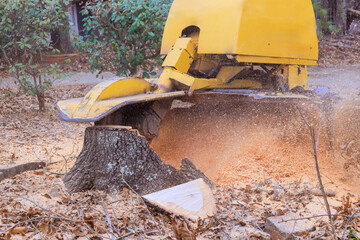
Tree removal often leaves behind one major challenge—a stubborn stump. These remnants are not only unsightly but can also create safety hazards, attract pests, and interfere with landscaping plans. Stump grinding is one of the most effective ways to eliminate stumps, providing property owners with a clean, safe, and attractive outdoor space.
Why Stump Grinding Matters
When trees are cut down, stumps can remain rooted in the ground for years. While some property owners leave them as they are, stumps bring several problems:
- Safety Hazards: Exposed stumps can cause trips and falls, especially in high-traffic areas.
- Pest Infestations: Rotting stumps often attract termites, ants, and other wood-boring insects.
- Landscape Limitations: Stumps take up valuable space that could be used for gardening, new trees, or outdoor features.
- Unattractive Appearance: A leftover stump disrupts the look of an otherwise tidy yard.
- Regrowth Issues: Some stumps sprout new shoots, requiring ongoing maintenance.
Stump grinding solves these issues by reducing stumps below ground level, leaving the area smooth and usable.
What is Stump Grinding
Stump grinding is a process that uses specialized machinery to shred the stump into small wood chips. Unlike complete stump removal, which requires digging out the entire root system, stump grinding focuses on grinding the stump down until it is no longer visible above the soil.
This method is efficient, cost-effective, and less invasive to the surrounding landscape. The wood chips created during grinding can be repurposed as mulch, making it an eco-friendly option as well.
Benefits of Stump Grinding
Choosing stump grinding offers multiple advantages for property owners:
- Quick and Efficient: The process is faster than full stump removal.
- Improved Curb Appeal: Eliminating stumps enhances the beauty of outdoor spaces.
- Safe Outdoor Space: Reduces tripping hazards and creates a smoother landscape.
- Prevents Pests: Removes decaying wood that attracts unwanted insects.
- Prepares for New Growth: Makes it possible to plant grass, shrubs, or new trees in the same area.
- Environmentally Friendly: Provides natural mulch that can enrich soil.
These benefits make stump grinding the preferred method for most homeowners and businesses.
Residential Stump Grinding
For homeowners, stumps can interfere with landscaping goals and reduce yard usability. Families with children or pets especially benefit from stump removal, as it creates safer play areas. Grinding stumps also allows homeowners to expand gardens, build patios, or simply maintain a well-kept lawn.
Many property owners schedule stump grinding after tree removal to complete the process and enjoy a cleaner, more functional outdoor space.
Commercial Stump Grinding
Businesses and public spaces also benefit greatly from stump grinding. Stumps left on commercial properties can create liability risks if someone trips or if pests spread to nearby structures. Professional stump grinding ensures a neat and safe environment, which is important for maintaining a positive impression with clients, customers, and visitors.
Commercial properties often require stump grinding for landscaping projects, construction, or property upgrades. Removing stumps helps maximize outdoor space and improves the overall appearance of business locations.
Stump Grinding vs Stump Removal
While both methods aim to eliminate tree stumps, there are key differences:
- Stump Grinding: Focuses on grinding the stump below ground level. It is faster, less invasive, and leaves roots in the ground to decompose naturally.
- Stump Removal: Involves digging out the stump and the entire root system. This method is more labor-intensive and may disturb the surrounding soil and landscaping.
For most situations, stump grinding is the preferred choice due to its efficiency and minimal impact on the property. Stump removal is typically chosen only when complete root extraction is necessary for construction or major landscaping projects.
How the Stump Grinding Process Works
The process of stump grinding is straightforward but requires specialized equipment and expertise:
- Assessment: The stump and surrounding area are evaluated to determine the best approach.
- Preparation: Any rocks, debris, or obstacles are cleared to protect the grinder.
- Grinding: The stump grinder is positioned over the stump, and rotating blades chip away at the wood until it is ground below soil level.
- Cleanup: The wood chips are either left as mulch or removed, depending on the property owner’s preference.
The area can then be replanted, landscaped, or left open for future projects.
Safety Considerations in Stump Grinding
While stump grinding is effective, it requires proper handling to ensure safety. Professional operators use protective gear and follow safety guidelines to prevent accidents. Attempting to grind stumps without the right equipment or training can be dangerous. For this reason, most property owners rely on professional services for reliable and safe results.
Eco-Friendly Use of Wood Chips
One of the unique advantages of stump grinding is the production of wood chips. Instead of going to waste, these chips can be used as mulch in gardens or landscaping. Mulch helps retain soil moisture, regulate temperature, and suppress weeds. This eco-friendly benefit makes stump grinding a sustainable choice.
When to Schedule Stump Grinding
The best time for stump grinding is soon after tree removal, but it can be done at any stage. Waiting too long may allow stumps to decay or attract pests. Property owners planning new landscaping or construction projects should schedule stump grinding early to clear the area for improvements.
Stump grinding is an efficient, safe, and eco-friendly solution for eliminating unwanted tree stumps. By improving safety, enhancing aesthetics, and preventing pest problems, it transforms outdoor spaces into clean and usable areas. Whether for homes or businesses, stump grinding provides lasting benefits that support landscaping goals and property value.
Instead of leaving unsightly stumps behind, property owners can invest in stump grinding to enjoy a smooth, safe, and beautiful landscape.
